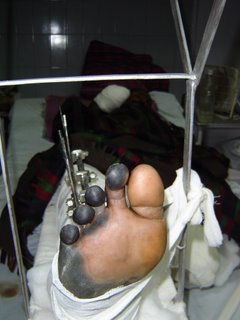Past imperfect, future tense
 It is a moot point whether Bant Singh of Jhabbar village, of remote Mansa district in Punjab, would have been attacked had he not joined the Mazdoor Mukti Morcha.
It is a moot point whether Bant Singh of Jhabbar village, of remote Mansa district in Punjab, would have been attacked had he not joined the Mazdoor Mukti Morcha.Perhaps they would have spared him had he not successfully campaigned for the cancellation of the licence of an upper-caste ration depot manager.
It would have taken some doing to spare him though, for he is a Dalit and that is a bad thing in today’s Punjab.
To top it all, he had successfully fought a court battle against retainers of dominant Jat landholders, who raped his minor daughter. Surely, it is a miracle in itself that the sessions court in Punjab had committed the rapists to a life sentence in 2002.
That is a seriously long list of audacities for a Dalit, particularly in Punjab. Bant is known as a singer of rousing protest songs. A long-time sympathiser of the CPI(ML) movement, he had been engaged for some months in mobilising labourers as part of preparations for the national conference of the All India Agrarian Labour Association.
On the evening of January 5, Bant Singh was returning home after making enrollments for the forthcoming conference. He was waylaid by seven persons, at the behest of the current and former village heads, Jaswant Singh and Niranjan Singh.
They assaulted Bant, using axes, iron rods and the handle of a hand pump. Incidentally, Jaswant and Niranjan’s relatives were convicted for Bant’s daughter’s rape.
Heavy blows
At the Mansa Civil Hospital, Dr Purushottam Goel demanded a bribe for Bant’s treatment and did not attend to him till 36 hours from the time of admission.
Bant’s wounds were bandaged only on the seventh day, and the next day his attendants were told — apparently at the instance of local Congress bigwigs — that the hospital lacked facilities to treat him. By the time Bant was shifted to the PGI, Chandigarh, it was too late to save both his hands and a leg.
Now, Bant Singh lies in a hospital in Chandigarh. To his grieving comrades, he said, “They’ve only got my limbs, I’ve still got my voice — I can still sing!”
Grim picture
You can visit http://www.punjabdalitsolidarity.blogspot.com and sign a petition in Bant’s support. Once you’ve done that, give this a thought. Punjab is the land of Sikhism, the faith that started as a healing bridge between Hinduism and Islam.
Why is it that today, that Punjab and Haryana account for maximum violence against Dalits? Was it not at Gohna, a district in Haryana, some months ago that an entire Dalit mohalla was razed?
Are not the Panchayats of western UP and Haryana most infamous for prosecuting Dalits and Jatavs who have relations with upper-caste women?
The divide runs deep
I had a foretaste of the situation in Punjab from Ajay Bhardwaj’s splendid film on Dalit Sufis of Punjab, Kitte Mil ve Mahi. As Sufi-revolutionary Lal Singh Dil, says in Bhardwaj’s film, “The Chamars are Adivasis, the shuruaati log, who were evicted from their lands by usurpers who came later… but the fact is that Chamars in Punjab are in very bad shape.”
The film takes us to the world of Dalit Sufi shrines in Punjab, some of them old, some newly erected as Dalits try and create a syncretic world of icons, images and traditions for a corner of their own.
This Sufism though, does not find many takers among Muslims and on many occasions, Jat Sikhs and other upper castes have come down heavily on these symbols of Dalit assertion, burning down shrines, preventing people from gathering there, restricting worship.
There are also several Dalit gurudwaras in Punjab, as the upper castes would not allow them to worship in others. As another character in Bhardwaj’s film says, “So many Gurus have come and gone but the Dalits are still where they were.”
Root cause
The reason why Bant needed to be so severely put down lies, ironically, in his success. Bant waged a successful resistance for long. Dalits could construct and maintain these shrines as they could organise themselves. Sangthan is the key to the fight against social justice.
I am happy at least one Communist party is trying to do that. Wouldn’t it be nice though if the mahi of Sufi shrines and of Mazdoor Morchas can come together — when shall the twain meet? For a deeper insight into the matter, watch Bharadwaj’s film. Write to ajayunmukt@yahoo.com.
Mahmood Farooqui, Mid-Day
http://ww1.mid-day.com/columns/mahmood_farooqui/2006/february/129994.htm

0 Comments:
Post a Comment
<< Home